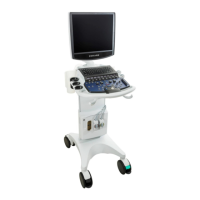Warnings - ECG
•
The ECG and the Respirometer functionality are not intended for ECG diagnosis. It must not be
used for intraoperative applications of the heart. Use only the recommended patient cable
supplied by Mindray. Make sure that bare parts of the electrodes and the patient do not come in
contact with conductive parts, such as metal examination beds, trolleys, and similar items.
•
Before defibrillation, always disconnect the ECG cable connector from the system and make sure
the connector does not come in contact with other persons or conductive surfaces, such as metal
examination beds, trolleys, and similar items.
•
Operating your system with ECG signals below 0.25 mV may cause inaccurate results.
Warnings – TEE Transducer
•
The multiplane TEE transducer should be used only by a qualified physician who has received
appropriate training in proper operation of the probe and in endoscopic techniques as dictated
by current relevant medical practices.
•
Electrical Hazard: Any evidence of damage indicates the probe cannot be used and should
be returned to Mindray for evaluation and repair.
•
Biological Hazard: Adequate cleaning and, if necessary, disinfection are carried out to prevent
disease transmission. It is the responsibility of the user to verify and maintain the effectiveness
of the procedure used. A single-use, sterile disposable sheath for TEE purposes can be used.
•
Inspect the transducer connector pins for contamination or damaged pins that might interrupt
signal flow through the connection. Be sure to check pins before connecting transducer to the
ultrasound system. If pins are bent, broken, or missing, do not use the transducer and call
Mindray Technical Support.
•
Immediately replace a transducer that exhibits any damage symptoms.
•
Before introducing the probe, do not rub or spray the tip of the probe with an anesthetic agent.
•
Avoid forceful manipulations and excessive force in using the probe that could result in patient
injury.
•
Withdraw the probe only with the deflection control in the unlock mode and with the distal end
of the probe straight.
•
The use of a bite guard is mandatory. Failure to use the bite guard may result in damage to the
probe, which could result in a safety hazard. Damage to the probe due to biting is not covered
by the probe's warranty.
•
Check if the maximum deflection of the tip is 90° to 120° upward, 60° to 90° downwards and
30° to 45° left/right. If the deflection shows an unwanted amount of free play or exceeds the
maximal deflection angles given above, do not use the probe. Contact the service
organization to re-adjust the steering of the probe. In this way, the risk of "buckling" or "U-
turning" of the probe in the esophagus is minimized.
•
Avoid damage to the probe by allowing nothing to protrude beyond the case when closing
the lid.
•
Prior to cleaning any device, turn off the system and disconnect power cord from AC
power source to avoid electrical shock.
•
Always use protective eyewear and clothing when cleaning or disinfecting the transducers.
•
Do not allow the disinfectant to come in contact with metal surfaces (transducer connector).
Use a soft cloth and warm soapy water to remove any disinfectant that remains on metal
surfaces.
•
Keep the control handle and transducer connector out of any cleaning or disinfection solutions.
The control handle and cable may be cleaned with a damp cloth, but only the distal end of the
probe up to the 100cm marker on the shaft may be placed into a disinfection solution.

